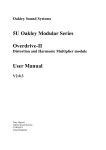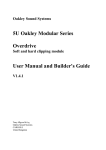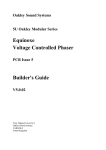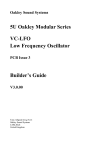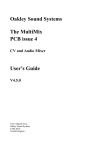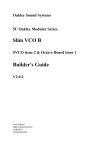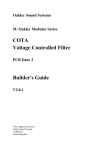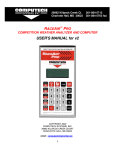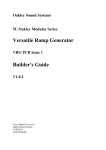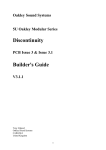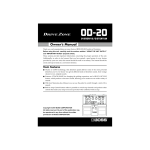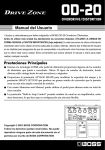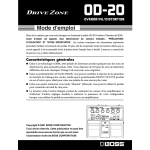Download Overdrive-II Builder`s Guide
Transcript
Oakley Sound Systems 5U Oakley Modular Series Overdrive-II Distortion and Harmonic Multiplier module Builder's Guide V2.0.4 Tony Allgood Oakley Sound Systems CARLISLE United Kingdom Introduction This is the Project Builder's Guide for the issue 1 Overdrive-II 5U module from Oakley Sound. This document contains a basic introduction to the board, a full parts list for the components needed to populate the board, a list of the various interconnections and a circuit description. For the User Manual which contains a basic overview of the module, a summary of its operation, and a personal perspective from the author, please visit the main project webpage at: http://www.oakleysound.com/overdrv.htm For general information regarding where to get parts and suggested part numbers please see our useful Parts Guide at the project webpage or http://www.oakleysound.com/parts.pdf. For general information on how to build our modules, including circuit board population, mounting front panel components and making up board interconnects please see our generic Construction Guide at the project webpage or http://www.oakleysound.com/construct.pdf. 2 The issue 1 Overdrive-II PCB On the printed circuit board I have provided space for the five main control pots. If you use the specified 16mm Alpha pots and matching brackets, the PCB can be held very firmly to the panel without any additional mounting procedures. The pot spacing on this board is different to many of our older 5U modules, instead of 1.625” it is 1.375”. Used in conjunction with smaller 20mm diameter knobs this still allows for an attractive module design and finger friendly tweaking. The design requires plus and minus 15V supplies. The power supply should be adequately regulated. The current consumption is around 25mA. Power is routed onto the main PCB by either our standard four way 0.156” MTA156 type connector or the special five way Synthesizers.com MTA100 header. The four pins are +15V, ground, earth/panel ground, -15V. The earth/panel connection allows you to connect the metal front panel to the power supply’s ground without it sharing the modules’ ground line. More about this later. The main PCB has four mounting holes for M3 bolts, one near each corner. These are not required for panel mounting if you are using the four 16mm pot brackets. The board size is 71mm (deep) x 158mm (high). No socket board is available for this project. Since the module only uses two sockets it was not considered worthwhile to use a special board for this purpose. The prototype Overdrive-II fitted to a natural finish Schaeffer MOTM format panel. 3 Circuit Description The module is powered in the conventional way from a split rail of +/-15V. This comes in to the module via the 0.156” MTA connector PWR. L1 and L2 in conjunction with C24, 26, 27 and 30 provide high frequency filtering and decoupling. They essentially act to keep the power supply as free from noise as possible. The main overdrive and distortion circuitry is actually run from a lower +/-5V supply. This is generated in the usual, if somewhat overkill, fashion of using two three terminal regulators, U3 and U5. These generate a very stable quiet low noise split 5V rail which the more sensitive parts of the overdrive circuitry can run. R28 and C22, and their negative equivalent, R29 and C33, provide additional filtering and isolation from main 15V rails. D11 to D14 provide discharge paths during power up and down cycles which could potentially harm the ICs on the circuit. The input signal is split into two; one pathway going to the overdrive circuitry, the other going to the INPUT/BLEND switch. The input/blend switch determines whether the harmonic multiplier circuit receives its audio input from the input directly or the output of the overdrive circuit. We will take a look at the overdrive circuitry first. This is top part of the schematic shown on page 1. The input signal is attenuated by an inverting amplifier block based around U2b (pins 6, 5 and 7). This circuit reduces the input signal to around a quarter and provides the following sections with a constant source impedance. Without this part of the circuit, the overdrive core and the blend pot may affect the source signal's integrity and cause unwanted distortion if you were using the Overdrive module in parallel with another module. U2b's output is then split, one side going to the blend pot which will provide the 'dry' signal, and the other side going into the overdrive's core circuitry. The core of the overdrive module is based around the same circuit as used in many guitar overdrive foot pedals. To my knowledge this type of design first appeared in the Ibanez Tubescreamer TS-808 pedal, but it also appears in other commercial pedals including the Boss OD-1 and SD-1, and other later Ibanez pedals. The TS-808 pedal has become something like the equivalent of the TB-303 in the guitar world and the original green units sell for a great deal of money. However, the basic circuit is actually quite simple and it is one that I have used in various home made pedals for some time. There are great deal of DIY TS-808 clones out there and many of them will talk about the huge differences in using different diodes and types op-amps. I found that, for synthesiser use at least, the actual sonic differences due to the actual devices used are not quite as obvious as internet lore has decreed. However, I will leave it to the builder to experiment here and I am sure that the Oakley forum would be a great place to discuss your findings. The key in the basic TS overdrive circuit is the usage of a standard non-inverting high gain opamp stage, U1a (pins 1, 2, 3), with two diodes in reverse parallel with the resistative feedback path. These diodes act to limit the voltage across the feedback resistor. These are shown in the schematic as D5 and D6. They can be switched in and out of the circuit with S1A, the 4 soft/hard selection switch. Because they act upon the feedback voltage and not the output signal directly they do not behave as a traditional clipping circuit. In the latter any signal is simply limited to a set maximum or minimum voltage. This circuit is more subtle than that. The gain of the op-amp non-inverting amplifier is set by the resistances within the feedback loop, but because of the way it works this is always more than or equal to one. That is, the output level is never less than the input. The exception to this is at very high frequencies when the op-amp reaches its operating limits. Ignoring the diodes for now, U1a has its passband gain set to a minimum of 11, via R2 and R3. The gain pot allows this gain to increase still further by increasing the feedback resistance. With the gain pot turned up full the maximum passband gain of the op-amp without the diodes is 111. A diode will behave in such a way as to limit the positive voltage across it to no more than 0.6V. It does this by effectively changing its resistance depending on the voltage it has across it. Two diodes connected in reverse parallel, head to tail, tail to head, will seek to limit the voltage across them to +/-0.6V. D5 and D6 are connected to act like this. So as the output level of U1a rises, either by turning up the gain pot or by applying a bigger input signal, so does the feedback voltage. Once the feedback voltage gets to beyond +0.6V or below -0.6V, the diodes start to conduct and the rise in output level is tempered. However, the gain of U1a cannot fall to below unity, so the diodes only appear to act on the amplified signal. Thus what we get at the output is a clipped amplified signal plus the original signal superimposed on it. This is the TS sound and it has great tonal characteristics. I ought to add that a great part of the overdrive sound is also due to frequency shaping. C5 rolls off the gain at lower frequencies. C6 and the slew rate of the op-amp act to curtail high frequency components. It is these that set the width of passband, that area in which the opamp acts as an amplifier. In addition C3 will effectively block any DC signals to the amplifier. The Oakley Overdrive has a major difference that the original TS doesn't have. We can switch out the diodes completely and allow U1a to become an unlimited high gain amplifier. But of course, everything has limits and this time the output is limited by the supply voltage to U1a. This is set by the +/-5V power supply and this causes the output to clip at around +4V for positive excursions and -4V for the negative. The op-amp cannot produce any output signal higher than this. However, when S1 switches out the two diodes in the feedback path, it also switches in, via S1B, two more reverse parallel diodes, D9 and D10. In conjunction with current limiter R19, these two diodes act as a traditional diode clipper and truncate the voltage across them to around +/-0.6V. This is the 'hard' mode and two different types of clipping are now possible in this mode. The diode clipping is apparent with high input signals with low gain, or low input signals with high gain. However, at high gains with medium to high input levels, both the opamp output limiting and diode clipping work together to give you a more pronounced effect. Immediately after the diode clipping circuit there is some additional high frequency filtering, based around the actions of R26 and C21. This low pass filter reduces the harshness and gives a rounded tone to the sound. Coupled with the bass end roll-off of C5, the overall frequency response over the distortion sections is focussed on the mid-range part of the audio spectrum. 5 The tone control is based around the classic TS and SD-1 design and is built around U1b. Its a simple circuit that works well in practice and produces enough tonal variation to be very useful. At the lowest setting of the Timbre pot C4 acts in conjunction with R19 to produce a single pole low pass filter. At the high end of the tone pot's travel, C4 now mostly acts in conjunction with the feedback resistor R22 and R5 and produces a shelving high pass filter. This boosts high frequencies and produces a much sharper sound. This is particularly apparent in the 'distortion' mode since this part of the circuit produces much more higher harmonics due to the more severe clipping affect. The output of the tone control stage is fed to the other end of the blend pot. This is a simple arrangement that lets the user apportion the mix of distorted and straight-through signal. The relatively high impedance output of the wiper of balance pot would not be able to drive the next part of the circuit, so it is buffered and amplified by a simple inverting amplifier U2a. The output of U2a is called DRIVE_OUT on the circuit diagram. Drive_out is fed to two places; one, to the in/blend switch, and two, to the balance pot. The latter allows the overdriven signal to be mixed with the output of the harmonic multiplier circuit much in the same way as the blend pot. U7b provides the buffering of the wiper voltage so that the output impedance of the module is set only by R21. This 1K resistor, found on many modules, limits the output current preventing instability with long cable connections and damage to U7b. It also allows you to directly connect the output to other module outputs within a multiple module. This serves then as a crude mixer where the resulting output is a sum of the two connected modules. Although once done quite a lot in the old days it is not terribly good practice as not all new modules feature such a resistor. The harmonic multiplier is based around two dual op-amps, U4 and U6. The fold pot acts as a simple volume control with U7a serving as a standard voltage follower or buffer circuit. U7a ensures that the following wavefolding circuits are fed from a very low output impedance which would not be the case had we used the voltage available directly at the wiper of the fold pot. There are two wavefolding stages in this harmonic multiplier. More stages were considered but for this particular module two was considered enough. Wavefolding can be done in a variety of ways but all rely on the basic principle of bending down the waveform peaks. This essentially means that the circuit's gain, like the overdrive circuitry described above, has a gain that varies with the input signal level. Unlike the overdrive circuit that simply reduces the gain at higher input signals, the wavefolder reverses the gain. That is, a positive going waveform is turned into a negative going one. If the input signal is large enough this mirroring of the waveform can even exceed the original signal level. If this new signal is now fed into another wavefolder circuit block then the mirrored parts of the waveform are mirrored once again. Each time there is a wavefolding action the sound radically changes and higher order harmonics are heard. U6a and U4a make up the first wavefolding section. As far as I know this is the first time that wavefolding has been done this way. The circuit will produce a different sound than other methods such as the middle section of the Serge Wavemultiplier and the late Jürgen Haible's Wavefolder. 6 The signal is split into two, one going into an inverting op-amp, U6a, of gain -6, and the other to a simple summing amplifier based around U4a. U6a has two 2.7V zener diodes in its feedback loop. This restricts the final output of U6a to +/-2.7V or thereabouts. The zeners do not act very strongly so the final output is gently squeezed as opposed to being clipped off sharply at 2.7V. Remember though that the signal is being amplified by -6 at this stage, so it only requires the input signal to reach +/-0.25V before the output shows signs of being clipped. Being an inverting amplifier the output of U6a is not only restricted but also inverted. This is important as the signal is now added to the original input signal by the inverting summing circuit of U4a. Note the resistor values of R9 and R8. The restricted output from U6a, some six times higher than it was, is now reduced by a factor of two thirds by the summing amplifier. So the overall gain of the signal going through U6a and U4a is +4. The original signal is inverted in the summing stage and it has a gain of -2. The overall effect is therefore a signal gain of +2 at signal levels below +/-0.25V and -2 at all signals above +/-0.25V. This change in the polarity of the gain that is dependant on the signal level produces the required wavefolding action. D1 and D2 provide additional restriction of the output first stage of wavefolding. These two diodes gently clip the output of U4a to +/-3.3V. This prevents very loud input signals from overfolding. This is what I call what happens when the folded parts of the waveform become so much greater than the input signal as to drown out the effects of the folding. The second stage of wavefolding is done with a similar circuit to the first. This time we do not need the overfolding diodes as it only needs to be done in the first stage. The second stage output from U6b is AC coupled into the balance pot by C19. C19 prevents any DC signals from reaching the balance pot and causing unpleasant crackling as the pot is turned. 7 Overdrive-II issue 1 Parts List For general information regarding where to get parts and suggested part numbers please see our useful Parts Guide at the project web page or http://www.oakleysound.com/parts.pdf. The components are grouped into values, the order of the component names is of no particular consequence. A quick note on European part descriptions. R is shorthand for ohm. K is shorthand for kiloohm. R is shorthand for ohm. So 22R is 22 ohm, 1K5 is 1,500 ohms or 1.5 kilohms. For capacitors: 1uF = one microfarad = 1000nF = one thousand nanofarad. To prevent loss of the small ‘.’ as the decimal point, a convention of inserting the unit in its place is used. eg. 4R7 is a 4.7 ohm, 4K7 is a 4700 ohm resistor, 6n8 is a 6.8 nF capacitor. Resistors 1% 0.25W or 0.4W metal film resistors are recommended. 47R 220R 1K 1K5 3K3 10K 11K 15K 22K 27K 33K 68K 100K 110K 360K R28, R29 R5 R3, R22, R21 R19 R1 R11, R2 R17, R10, R8 R27 R24, R13 R23 R4, R26, R20, R7, R9, R16 R14 R12, R25 R18 R6, R15 Capacitors 100nF axial multilayer ceramic C8, C17, C26, C16, C15, C12, C27, C9, C14, C11, C10, C13 10pF 2.5mm C0G ceramic 47pF 2.5mm C0G ceramic C7, C20 C18, C6 47nF, 100V polyester 150nF, 63V polyester 220nF, 63V polyester C21 C25 C4, C5 8 470nF, 63V polyester C1, C3, C2, C19 2u2, 63V electrolytic C22, C29, C23, C28, C30, C24 Discrete Semiconductors 1N4148 silicon diode 2.7V 400mW zener diode D5, D6, D9, D10, D11, D12, D13, D14 D1, D2, D3, D4, D7, D8 Integrated Circuits 78L05 5V 100mA regulator 79L05 -5V 100mA regulator OP275G dual op-amp TL072CN dual FET op-amp U3 U5 U1, U2 U4, U6, U7 There is some scope for using different op-amps to those I have suggested. However, the ones I have chosen are stable and sound good. IC sockets are to be recommended. You need five 8-pin DIL sockets. Potentiometers (Pots) All pots Alpha 16mm PCB mounted types 10K linear 47K or 50K linear 100K log TIMBRE BALANCE, BLEND, FOLD DRIVE Four 16mm pot brackets. Switches One single pole ON-ON (SPDT) toggle switch is required for the IN/BLEND selection. One double pole ON-ON (DPDT) toggle switch is required for the HARD/SOFT selection. Both switches are mounted on the panel and wired to the board with fly wires – see later for details. 9 Miscellaneous Leaded axial ferrite beads L1, L2 MTA156 4 way header MTA100 6-way header PSU PWR – Oakley/MOTM power supply – Synthesizers.com power supply Other Parts Required Switchcraft 112APC 1/4” sockets Two off mounted on panel Five 20mm knobs. Around 2m of insulated multistrand hook up wire for the switch and socket connections. 10 Connections Power connections – MOTM and Oakley The PSU power socket is 0.156” Molex/MTA 4-way header. Friction lock types are recommended. This system is compatible with MOTM systems. Power Pin number +15V Module GND Earth/PAN -15V 1 2 3 4 Pin 1 on the I/O header has been provided to allow the ground tags of the jack sockets to be connected to the powers supply ground without using the module’s 0V supply. Earth loops cannot occur through patch leads this way, although screening is maintained. Of course, this can only work if all your modules follow this principle. It's worth filling the empty holes of the PWR pads with solder. Power connections – Synthesizers.com The PWR power socket is to be fitted if you are using the module with a Synthesizers.com system. In this case you should not fit the PSU header. The PWR header is a six way 0.1” MTA, but with the pin that is in location 2 removed. In this way location 3 is actually pin 2 on my schematic, location 4 is actually pin 5 and so on. Power Location number Schematic Pin number +15V Missing Pin +5V Module GND -15V Not connected 1 2 3 4 5 6 1 2 3 4 5 +5V is not used on this module, so location 3 (pin 2) is not actually connected to anything on the PCB. If fitting the PWR header, you will also need to link out pins 2 and 3 of PSU. This connects the panel ground with the module ground. Simply solder a solid wire hoop made from a resistor lead clipping to join the middle two pads of PSU together. 11 Wiring the sockets If you have used Switchcraft 112 sockets you will see that they have three connections. One is the earth tag, one the bevelled edge. One is the signal tag which will be connected to the tip of the jack plug when it is inserted, its marked with a small T. The third tag is the normalised tag, or NC (normally closed) tag, and is marked T/S presumably standing for 'tip/switched'. The NC tag is internally connected to the signal tag when a jack is not connected. This connection is automatically broken when you insert a jack. In the Overdrive-II module we will be using the NC lug on the INPUT socket to short out the input line to ground when there is no jack inserted. Connect, with a piece of insulated wire, the following tags on each socket to the respective pad on the PCB: Socket Name Tag type PCB pad name INPUT INPUT INPUT OUTPUT OUTPUT Signal NC Earth Signal Earth IN GND PN1 OUT PN2 There is no connection made to the NC tag on the output socket. I have used black heatshrink tubing to act as a strain relief for the wiring to the sockets. 12 Wiring the Switches You have two switches to wire up. One of them is relatively straightforward and uses a SPDT switch, the other uses a DPDT switch and is slightly more complex. Let's get the hard one out of the way first. This is an APEM double pole double throw on-on toggle switch. Note the twisted wire pairs connecting the PCB to the switch. The first thing you need to do is to make up some twisted pairs of wires. These will be used to connect each pole of the hard/soft switch to the board. A twisted pair is exactly that, two wires twisted together to form a simple cable. The best way to make a twisted pair is to use a hand drill or slow moving battery powered drill. Take two one metre lengths of coloured insulated multistrand wire and tie them to something fixed like a door handle. Did he say door handle? I did, but you can be professional and use a bench vice if you wish. Straighten the wire out and push the two free ends into a chuck of the drill. Now hold the drill so that the wire is horizontal and fairly taught. Both wires should be the same length, if not, make sure they are. Now let the drill slow spin and the wires will twist together neatly. Don't make it too tight, but don't put too few turns on it either. Practice makes perfect as they say. You should be warned that when you release the wire, it tends to curl up a bit, but this is fine and you should have a nice twisted pair to work with. 13 You need to cut your new cable into two small pieces that will allow the switch to be connected to the board. If you are using the suggested front panel, then you will be fitting your switch so that the toggle moves up and down. Lay the module flat so that the front panel is facing away from you and the board is facing upwards lying flat on the work surface. Your fitted switch will have two sets of three contacts, and these will now be lying horizontally. The wiper contacts of the switch are the two middle pins, one above the other. Let us wire the bottom set of contacts first. These are to be connected to the pads on the board named S1A. Solder both wires of one of the twisted pairs to the pad S1A. There are two pads, so that each wire is connected to its own solder pad. The other end of your pair should now be soldered to the switch. But you have three contacts and only two wires in your pair. Solder one of the wire ends, it doesn't matter which, to the right hand tag of the bottom row of contacts. Then solder the remaining one to the middle tag. Now let us wire the top set of contacts. These are to be connected to the pads on the board named S1B. Solder both wires of the other twisted pair to the pad S1B. Again, there are two pads, so that each wire is connected to its own solder pad. The other end of this twisted pair should now be soldered to the switch. This time we are using a different part of the switch. So solder one of the wire ends, again it doesn't matter which, to the middle tag of the top row of contacts. Then solder the remaining one to the left hand tag. You can now use a couple of cable ties to hold the two twisted pairs together for neatness. The second switch is relatively easy to wire up. I use solid core tinned copper wire instead of insulated wire. Simply wire each solder tag of the switch to the empty solder pad directly below it. I normally bend the wire at one end into a hook and place the straight end into the PCB pad's hole. I then loop the hooked end around the switch tang and squash the hook into place before soldering it. The solder pad on the board can then be soldered from the underside and the excess wire on snipped off. The 'in/blend' switch can be wired with either insulated wire or solid core wire as shown above. 14 Final Comments If you have any problems with the module, an excellent source of support is the Oakley Sound Forum at Muffwiggler.com. Paul Darlow and I are on this group, as well as many other users and builders of Oakley modules. If you can't get your project to work, then Oakley Sound Systems are able to offer a 'get you working' service. If you wish to take up this service please e-mail me, Tony Allgood, at my contact e-mail address found on the website. I can service either fully populated PCBs or whole modules. You will be charged for all postage costs, any parts used and my time at 25GBP per hour. Most faults can be found and fixed within one hour, and I normally return modules within a week. The minimum charge is 25GBP plus return postage costs. If you have a comment about this builder's guide, or have a found a mistake in it, then please do let me know. But please do not contact me or Paul Darlow directly with questions about sourcing components or general fault finding. Honestly, we would love to help but we do not have the time to help everyone individually by e-mail. Last but not least, can I say a big thank you to all of you who helped and inspired me. Thanks especially to all those nice people on the Synth-diy and Analogue Heaven mailing lists and at Muffwiggler.com. Tony Allgood at Oakley Sound Cumbria, UK © August 2012 No part of this document may be copied by whatever means without my permission. 15















